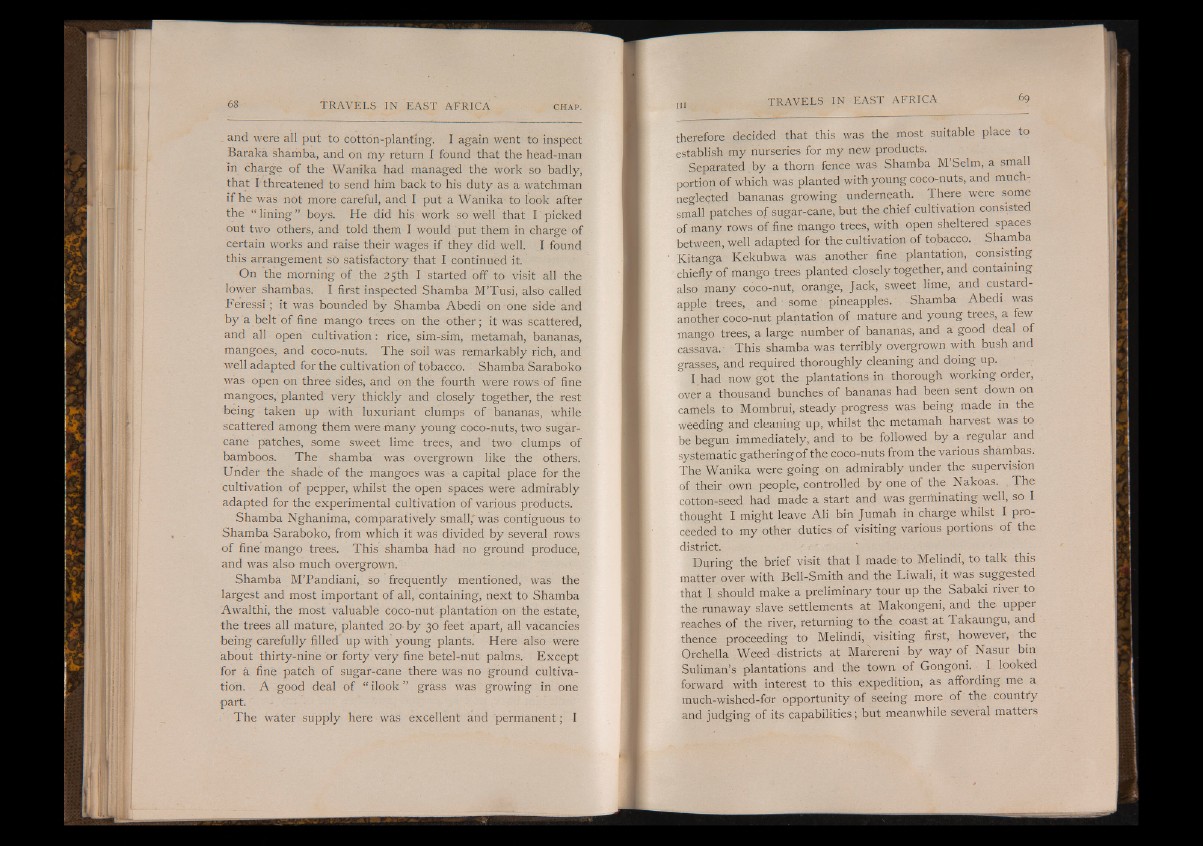
. and were all put to cotton-planting. I again went to inspect
Baraka shamba, and on my return I found that the head-man
in charge of the Wanika had managed the work so badly,
that I threatened to send him back to his duty as a watchman
if he was not more careful, and I put a Wanika to look after
the “ lining ” boys. He did his work so well that I picked
but two others, and told them I would put them in charge of
certain works and raise their wages if they did well. I found
this arrangement so satisfactory that I continued it.
On the morning of the 25th I started "off to visit all the
lower shambas. I first inspected Shamba M’Tusi, also called
Feressi; it was bounded by Shamba Abedi on one side and
by a belt of fine mango trees on the other; it was scattered,
and all open cultivation : rice, sim-sim, metamah, bananas,
mangoes, and coco-nuts. The soil was remarkably rich, and
well adapted for the cultivation of tobacco. Shamba Saraboko
was open on three sides, and On the fourth were rows of fine
mangoes, planted very thickly and closely together, the rest
being taken up with luxuriant clumps of bananas, while
scattered among them were many young coco-nuts, two sugarcane
patches, some sweet lime trees, and two clumps of
bamboos. The shamba was overgrown like the others.
Under the shade of the mangoes was a capital place for the
cultivation of pepper, whilst the open spaces were admirably
adapted for the experimental cultivation of various products.
Shamba Nghanima, comparatively small'was contiguous to
Shamba Saraboko, from which it was divided by several rows
of fine mango trees. This shamba had no ground produce,
and was also much overgrown.
Shamba M’Pandiani, so frequently mentioned, was the
largest and most important of all, containing, next to Shamba
Awalthi, the most valuable coco-nut plantation on the estate,
the trees all mature, planted 20. by 30 feet apart, all vacancies
being carefully filled up with young plants. Here also were
about thirty-nine or forty very fine betel-nut palms. Except
for a fine patch of sugar-cane there was no ground cultivation.
A good deal of “ ilook” grass was growing in one
part.
The water supply here was excellent and permanent; I
therefore decided that this was the most suitable place to
establish my nurseries for my new products.
Separated by a thorn fence was Shamba M’Selm, a small
portion of which was planted with young coco-nuts, and much-
neglected bananas growing underneath. There were some
small patches of sugar-cane, but the chief cultivation consisted
of many rows of fine mango trees, with open sheltered spaces
between, well adapted for the cultivation of tobacco. Shamba
Kitanga Kekubwa was another fine plantation, consisting
chiefly of mango trees planted closely together, and containing
also many coco-nut, orange, Jack, sweet lime, and custard-
apple trees, and ■ some - pineapples. Shamba Abedi was
another coco-nut plantation of mature and young trees, a few
mango trees, a large number of bananas, and a good deal of
cassava.- This shamba was terribly overgrown with bush and
grasses, and required thoroughly cleaning and doing up.
I had now got the plantations in thorough working order,
over a thousand bunches of bananas had been sent down on
camels to Mombrui, steady progress was being made in the
weeding and cleaning up, whilst the metamah harvest was to
be begun immediately, and to be followed by a regular and
systematic gathering of the coco-nuts from the various shambas.
The Wanika were going on admirably under the supervision
of their own people, controlled by one of the Nakoas. The
cotton-seed had made a start and was germinating well, so I
thought I might leave Ali bin Jumah in charge whilst I proceeded
to my other duties of visiting various portions of the
district.
During the brief visit that I made to Melindi, to talk this
matter over with Bell-Smith and the Liwali, it was suggested
that I should make a preliminary tour up the Sabaki river to
the runaway slave settlements at Makongeni, and the upper
reaches of the river, returning to the coast at Takaungu, and
thence proceeding to Melindi, visiting first, however, the
Orchella Weed districts at Marereni by way of Nasur bin
Suliman’s plantations and the town of Gongoni. I looked
forward with interest to this expedition, as affording me a
much-wished-for opportunity of seeing more of the country
and judging of its capabilities; but meanwhile several matters